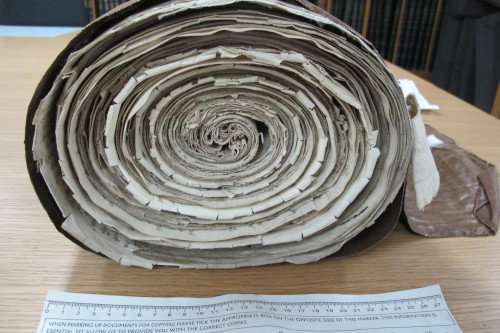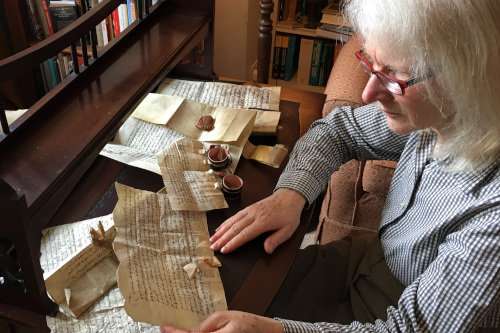Credit: University of Bristol
Historians from the University of Bristol have uncovered compelling new evidence concerning the first English-led expedition to North America in 1499 hidden deep within huge parchment rolls and only legible by using ultra-violet light.
Nine years ago, Dr. Evan Jones from the University's Department of History, published a long-lost letter from King Henry VII which revealed that William Weston, a Bristol merchant, was preparing an expedition to the "new found land" with the King's support.
His venture was just a year after Christopher Columbus first landed on the mainland of South America and two years after the Venetian explorer, John Cabot, reached North America from the English port of Bristol.
Weston's expedition was probably undertaken under the royal patent issued to John Cabot in 1496. But what happened afterwards was unclear.
Now Dr. Jones and Margaret Condon, from the University of Bristol-led Cabot Project, have discovered that Weston received a £30 reward from the King in 1500 as a contribution to the merchant's expenses for his exploration of 'nova terra' (the 'new land').
The reward was equivalent to about six years' pay for an ordinary labourer, suggesting that the King was pleased with the outcome.
The key entry was a result of Condon's painstaking detective work, trawling through official tax records. Each of the accounts take the form of a huge parchment roll, made from the skin of over two hundred sheep. Each 'membrane' in this roll is two metres long, while the note itself was so faint it is only legible under ultra violet light.
"First time I read the roll, I almost missed it!" said Condon. "These rolls are beasts to deal with, but also precious and irreplaceable documents. Handling them, it sometimes feels like you're wrestling, very gently, with an obstreperous baby elephant!"
The authors, publishing today in the journal Historical Research, further reveal that Cabot and Weston received rewards in January 1498, following an audience with Henry VII. It seems the two explorers were working together long before Weston went off on his 1499 expedition.
Weston was probably one of the unnamed 'great seamen' from Bristol discussed by Italian diplomats and merchants in the winter of 1497/8. Letters the Italians sent back home from London confirm that Cabot had Bristol companions on his 1497 expedition and claim that his supporters from the port were 'the leading men' behind the 1498 expedition.
Credit: University of Bristol
The outcome of Cabot's final expedition in 1498 is unknown, and it is unclear whether any of the ships returned. That may explain King Henry's willingness to send out another expedition the following year, led by one of Cabot's deputies.
Dr. Jones said: "Finding this new evidence is wonderful! What's amazing about these early Bristol voyages is how little we've ever known about them.
"Cabot's voyages have been famous since Elizabethan times and were used to justify England's later colonisation of North America. But we've never known the identity of his English supporters. Until recently, we didn't even know that there was an expedition in 1499."
Other evidence found by the Bristol researchers fill out Weston's life. "He was a bit of a gambler" says Condon, "but then so was Cabot. Perhaps you had to be, to risk your life on such a dangerous voyage into unknown seas."
The new research also confirms two of the extraordinary claims made by a deceased historian, Dr. Alwyn Ruddock of the University of London. Over a 40-year period she unearthed much new evidence about England's first voyages to North America. She suggested that Cabot had explored most of the continent's east coast by 1500. But she never published her findings and, in an extraordinary turn of events, had all her notes destroyed on her death in 2005.
One of Ruddock's claims was that a group of Italian friars, who accompanied Cabot's 1498 expedition, went on to establish Europe's first Christian colony and church in North America. Ruddock implied that Weston visited this Newfoundland settlement the following year, before proceeding up the coast of Labrador in search of a northwest passage around the continent. It was for this that Weston was rewarded.
Since 2009, Jones and Condon have been working with an international group of historians and archaeologists to investigate Ruddock's claims and relocate the evidence that underpinned them.
Condon added: "I think we've got well over half of the documents Ruddock located but there are definitely more, especially in Italy. She did a lot of work there, including in the private archives of some of Italy's great noble families. It's a thrill when another piece of evidence turns up."
Although the Cabot Project has yet to find all the evidence that Alwyn Ruddock unearthed, they are determined to publish what they have as they go along.
"We don't want to 'do a Ruddock'", said Dr. Jones. "We can't confirm all her claims and we think she got some things wrong. But it's better to publish research as you go along, rather than to sit on your finds for decades, while searching for the last pieces of the jigsaw."
Condon added "I didn't believe Alwyn Ruddock when she wrote that William Weston was 'well-documented' – but she was right. It just took a lot of time, determination and UV light to flesh out the details."
More information: Margaret M. Condon and Evan T. Jones, 'William Weston: early voyager to the New World', Historical Research (August, 2018)
Journal information: Historical Research
Provided by University of Bristol

























